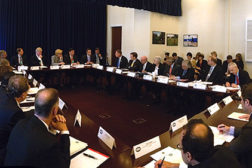Home » regulations for HVACR
Articles Tagged with ''regulations for HVACR''
Manufacturers, Organizations Look to Reduce Hydrofluorocarbon Use 80 Percent by 2050
Read More
Regional HVAC Standards Impact Surveyed
Many Contractors Still Uninformed About Coming Changes, Survey Shows
September 22, 2014
European Legislation Landscape Won't Get Any Easier, Says New HEVAC President
HVAC Industry Needs to Tackle the Skills Shortage to Meet the Challenge of Tougher Regulations and Standards
Read More
Aug. 29, 2014: Survey Shows Some HVAC Contractors Optimistic about 2015 Efficiency Standards
Opportunity for Higher Revenues Seen as Upside of Increasing Efficiency Standards
August 29, 2014
Man Gets Prison Time for Venting R-22
Ohio Man Pleads Guilty to Violating Federal Clean Air Act
Read More
ASHRAE Showcases New Strategic Plan at 2014 Annual Conference
Indoor Environment Quality Global Alliance Brings ASHRAE, IAQA, Others Together
Read More
EPA Cautions Against Using Propane-based Refrigerants
FBI Joins EPA in Issuing Warnings About Unapproved Refrigerants
August 11, 2014
DOE Forms Regional Standards Enforcement Working Group
Group Aims to Produce a Satisfactory Enforcement Solution by Oct. 31
August 4, 2014
Copyright ©2024. All Rights Reserved BNP Media.
Design, CMS, Hosting & Web Development :: ePublishing








